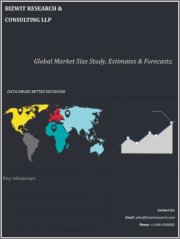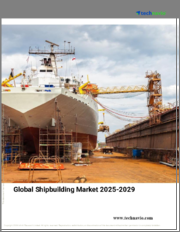
|
시장보고서
상품코드
1269752
세계의 함정 건조 시장 규모 조사 및 예측 : 유형별, 용도별, 지역별 분석(2022-2029년)Global Naval Shipbuilding Market Size study & Forecast, by Type (Propeller, Water Jet, Special Thruster) by Application (Coastal defense, Maritime combat, Marine supply, Others) and Regional Analysis, 2022-2029 |
||||||
함정 건조(Naval Shipbuilding)란 군사 목적으로 사용되는 선박(함정)을 설계, 건조, 유지하는 과정을 말합니다.
이 선박은 해양 환경에서 운영을 위해 특별히 건설되었으며 해상 군사 작전을 지원하기 위한 무기 및 기타 시스템을 갖추고 있습니다. 함정 건조 시장이 확대되고 있는 것은, 지정학적 분쟁 증가나 해상 거래 증가 등 요인에 의한 것입니다.
선박 설계, 무기 시스템 설치, 선박 건조는 모두 함정 건조에 포함됩니다. 또한 해군 함정은 성능 및 안전 요구 사항을 충족하는지 확인하기 위해 테스트 및 평가를 받습니다. 미국외교협회에 따르면 미국과 중국은 남중국해의 섬과 해역의 영유권을 놓고 이견을 보여 왔습니다. 중국은 천연자원이 풍부하고 주요 항로인 남중국해 대부분을 자국 영토라고 주장해 왔으며, 미국은 항행과 상공 비행의 자유를 주장해 왔습니다. 미국은 중국의 영유권 주장에 이의를 제기하기 위해 이 지역에서 영유권 분쟁이 있는 섬이나 지역으로 해군 함정을 보내는 항행의 자유 작전을 여러 차례 실시했습니다. 이러한 작전으로 인해 때때로 중국 군함과의 근접 조우 및 경고가 발생하기도 했습니다. 공간 증가를 이끄는 또 다른 중요한 요소는 해상 무역의 수입니다. Statista에 따르면 2020년 아시아는 전 세계 해상 무역의 대부분을 차지했습니다. 이 지역의 항구는 전 세계 해상 운송량의 약 42%를 선적하고 약 67%를 하역했으며, 중국은 세계 최대 규모의 항구를 보유하고 있습니다. 또한 2021년 전 세계 해상 무역량은 약 110억 톤이 될 것으로 예상됩니다. 또한 조선 기술의 발전과 해상 감시에 대한 수요 증가는 예측 기간 동안 시장에 대한 수익성있는 성장 전망을 창출 할 것입니다. 그러나 함정 건조의 고비용은 2022년부터 2029년까지의 예측 기간을 통해 시장 성장을 저해합니다.
세계의 함정 건조 시장 조사에서 고려된 주요 지역은 아시아 태평양 지역, 북미, 유럽, 중남미 및 기타 지역입니다. 북미는 국경을 넘어 감시 수요가 증가하고 해군 근대화에 대한 중점이 높아짐에 따라 수익면에서 시장을 독점하고 있습니다. Statista에 따르면 2023년 미국 해군은 49척의 원자력공격형 잠수함과 11척의 항공모함을 보유하고 있습니다. 또한 2023년에는 미국 해군이 보유한 전투 함정은 285척이 되었습니다. 또한 아시아 태평양 지역은 인근국가들의 해군 조달과 근대화를 위한 투자 증가와 시장 진출 기업의 적극적인 참여로, 예측 기간 동안 가장 높은 CAGR로 추이하며 성장할 것으로 예상됩니다.
이 조사의 목적은 최근 몇 년 동안 다양한 부문와 국가 시장 규모를 밝히고 앞으로 수년간 시장 규모를 예측하는 것입니다. 이 보고서는 조사 대상 국가의 산업의 질적 및 양적 측면을 통합하도록 설계되었습니다.
또한 시장의 향후 성장을 규정하는 촉진 요인과 과제 등 중요한 측면에 대한 자세한 정보도 제공하고 있습니다. 또한 주요 기업의 경쟁 상황과 제품 제공에 대한 상세한 분석과 함께, 이해관계자가 투자할 수 있는 거시적 시장의 잠재적인 기회도 포함하고 있습니다.
목차
제1장 주요 요약
- 시장 스냅샷
- 전 세계·부문별 시장 추정 및 예측(2019-2029년)
- 함정 건조 시장, 지역별(2019-2029년)
- 함정 건조 시장, 유형별(2019-2029년)
- 함정 건조 시장, 용도별(2019-2029년)
- 주요 동향
- 조사 방법
- 조사의 전제 조건
제2장 세계의 함정 건조 시장 정의 및 범위
- 조사 목적
- 시장 정의 및 범위
- 조사 대상 범위
- 산업 진화
- 조사 대상 년도
- 환율
제3장 세계의 함정 건조 시장 역학
- 함정 건조 시장 영향 분석(2019-2029년)
- 시장 촉진 요인
- 지정학적 갈등 격화
- 늘어나는 해양 무역업
- 시장 과제
- 함정 건조의 막대한 비용
- 시장 기회
- 조선 기술의 진보
- 해상 감시 수요 확대
- 시장 촉진 요인
제4장 세계의 함정 건조 시장 및 산업 분석
- Porter’s Five Forces
- 공급기업의 협상력
- 구매자의 협상력
- 신규 참가업체의 위협
- 대체품의 위협
- 경쟁 기업 간 적대 관계
- Porter’s Five Forces에 대한 미래적 접근법(2019-2029년)
- PEST 분석
- 정치적
- 경제적
- 사회적
- 기술적
- 주요 투자 기회
- 주요 성공 전략
- 산업 관계자 전망
- 애널리스트의 권고 및 결론
제5장 위험 평가 : COVID-19의 영향
- COVID-19가 산업에 주는 전체적인 영향에 대한 평가
- COVID-19 이전과 COVID-19 이후 시장 시나리오
제6장 함정 건조 시장 : 유형별
- 시장 스냅샷
- 함정 건조 시장 : 유형별, 실적-잠재력 분석
- 함정 건조 시장 : 유형별 추정 및 예측(2019-2029년)
- 함정 건조 시장, 서브 부문 분석
- 프로펠러
- 워터 제트
- 특수 슬러스터
제7장 함정 건조 시장 : 용도별
- 시장 스냅샷
- 함정 건조 시장 : 용도, 실적-잠재력 분석
- 함정 건조 시장 : 용도별, 추정 및 예측(2019-2029년)
- 함정 건조 시장, 서브 부문 분석
- 연안 국방
- 해상 전투
- 해상 보급
- 기타
제8장 해군조선 시장 : 지역별 분석
- 함정 건조 시장, 지역별 시장 스냅샷
- 북미
- 미국
- 유형별 추정 및 예측(2019-2029년)
- 용도별 추정 및 예측(2019-2029년)
- 캐나다
- 미국
- 유럽의 함정 건조 시장 스냅샷
- 영국
- 독일
- 프랑스
- 스페인
- 이탈리아
- 기타 유럽
- 아시아 태평양의 함정 건조 시장 스냅샷
- 중국
- 인도
- 일본
- 호주
- 한국
- 기타 아시아 태평양 지역
- 남미의 함정 건조 시장 스냅샷
- 브라질
- 멕시코
- 기타 남미 지역
- 기타 지역
제9장 경쟁 정보
- 주요 시장 전략
- 기업 개요
- ThyssenKrupp Marine Systems AG
- 주요 정보
- 개요
- 재무(데이터의 입수가 가능한 경우만)
- 제품 개요
- 최근 동향
- Damen Schelde Naval Shipbuilding(DSNS)
- BAE Systems plc
- Abu Dhabi Ship Building(ADSB)
- Lockheed Martin Corporation
- Huntington Ingalls Industries Inc
- ASC Pty Ltd
- Thales group
- Hyundai Heavy Industries Co., Ltd.
- Mazagon Docks Limited
- ThyssenKrupp Marine Systems AG
제10장 조사 프로세스
- 조사 프로세스
- 데이터 마이닝
- 분석
- 시장 추정
- 검증
- 출판
- 조사의 특징
- 조사의 전제 조건
Global Naval Shipbuilding Market is valued at approximately USD xxx billion in 2021 and is anticipated to grow with a healthy growth rate of more than xxx% over the forecast period 2022-2029. Naval shipbuilding refers to the process of designing, constructing, and maintaining ships that are used for military purposes. These ships are specifically built to operate in a maritime environment and are equipped with weapons and other systems to support military operations at sea. The Naval Shipbuilding market is expanding because of factors such as increasing geo-political conflicts and the growing number of maritime trades.
The design of the ship, installation of weapons systems, and construction of the vessel are all part of naval shipbuilding. The naval ship is also tested and evaluated to ensure that it meets performance and safety requirements. According to the Council on Foreign Relations, The United States and China have had disagreements over the sovereignty of islands and maritime areas in the South China Sea. China has claimed most of the South China Sea, which is rich in natural resources and a key shipping lane, as its own territory, while the U.S. has insisted on the freedom of navigation and overflight. The U.S. has conducted several freedoms of navigation operations in the area, which involve sending naval vessels close to disputed islands or areas, to challenge China's claims. These operations have sometimes resulted in close encounters and warnings from Chinese military vessels. Another important component driving space increase is the number of maritime trades. As per Statista, in 2020 Asia accounted for most of the global maritime trade. The ports of the region loaded nearly 42% and unloaded roughly 67% of all goods transported by sea worldwide, China which accounts for some of the world's largest seaports. In addition, the volume of global seaborne trade is expected to be around 11 billion tons in 2021. Also, advancements in shipbuilding technologies and growing demand for seaborne surveillance would create a lucrative growth prospectus for the market over the forecast period. However, the high cost of Naval Shipbuilding stifles market growth throughout the forecast period of 2022-2029.
The key regions considered for the Global Naval Shipbuilding Market study includes Asia Pacific, North America, Europe, Latin America, and Rest of the World. North America dominated the market in terms of revenue, owing to the increasing demand for cross-border surveillance and rising emphasis on naval modernization. According to the Statista, In the year of 2023, the U.S. Navy had 49 Nuclear Attack Submarines and 11 aircraft carriers at their disposal. In total, the U.S. Navy had 285 battle force ships at their disposal in that year. Furthermore, Asia Pacific is expected to grow with the highest CAGR during the forecast period, owing to an increase in naval investments by the neighboring countries to procure and modernize their naval fleet, and active participation of government organizations in the market space.
Major market player included in this report are:
- ThyssenKrupp Marine Systems AG
- Damen Schelde Naval Shipbuilding (DSNS)
- BAE Systems plc
- Abu Dhabi Ship Building (ADSB)
- Lockheed Martin Corporation
- Huntington Ingalls Industries Inc
- ASC Pty Ltd
- Thales group
- Hyundai Heavy Industries Co., Ltd.
- Mazagon Docks Limited
Recent Developments in the Market:
- In February 2022, Lockheed Martin has been awarded a contract to supply MK 41 Vertical Launching System under the German Navy's F126 programme. This contract will help Lockheed increasing their naval capabilities and shipbuilding potential up to some extent.
Global Naval Shipbuilding Market Report Scope:
- Historical Data 2019-2020-2021
- Base Year for Estimation 2021
- Forecast period 2022-2029
- Report Coverage Revenue forecast, Company Ranking, Competitive Landscape, Growth factors, and Trends
- Segments Covered Type, Application, Region
- Regional Scope North America; Europe; Asia Pacific; Latin America; Rest of the World
- Customization Scope Free report customization (equivalent up to 8 analyst's working hours) with purchase. Addition or alteration to country, regional & segment scope*
The objective of the study is to define market sizes of different segments & countries in recent years and to forecast the values to the coming years. The report is designed to incorporate both qualitative and quantitative aspects of the industry within countries involved in the study.
The report also caters detailed information about the crucial aspects such as driving factors & challenges which will define the future growth of the market. Additionally, it also incorporates potential opportunities in micro markets for stakeholders to invest along with the detailed analysis of competitive landscape and product offerings of key players. The detailed segments and sub-segment of the market are explained below.
by Type
- Propeller
- Water Jet
- Special Thruster
by Application
- Coastal defense
- Maritime combat
- Marine supply
- Others
By Region:
- North America
- U.S.
- Canada
- Europe
- UK
- Germany
- France
- Spain
- Italy
- ROE
- Asia Pacific
- China
- India
- Japan
- Australia
- South Korea
- RoAPAC
- Latin America
- Brazil
- Mexico
- RoLA
- Rest of the World
Table of Contents
Chapter 1. Executive Summary
- 1.1. Market Snapshot
- 1.2. Global & Segmental Market Estimates & Forecasts, 2019-2029 (USD Billion)
- 1.2.1. Naval Shipbuilding Market, by Region, 2019-2029 (USD Billion)
- 1.2.2. Naval Shipbuilding Market, by Type, 2019-2029 (USD Billion)
- 1.2.3. Naval Shipbuilding Market, by Application, 2019-2029 (USD Billion)
- 1.3. Key Trends
- 1.4. Estimation Methodology
- 1.5. Research Assumption
Chapter 2. Global Naval Shipbuilding Market Definition and Scope
- 2.1. Objective of the Study
- 2.2. Market Definition & Scope
- 2.2.1. Scope of the Study
- 2.2.2. Industry Evolution
- 2.3. Years Considered for the Study
- 2.4. Currency Conversion Rates
Chapter 3. Global Naval Shipbuilding Market Dynamics
- 3.1. Naval Shipbuilding Market Impact Analysis (2019-2029)
- 3.1.1. Market Drivers
- 3.1.1.1. Increasing geo-political conflicts
- 3.1.1.2. Growing number of maritime trades
- 3.1.2. Market Challenges
- 3.1.2.1. High Cost of Naval Shipbuilding
- 3.1.3. Market Opportunities
- 3.1.3.1. Advancements in shipbuilding technologies
- 3.1.3.2. Growing demand for seaborne surveillance.
- 3.1.1. Market Drivers
Chapter 4. Global Naval Shipbuilding Market Industry Analysis
- 4.1. Porter's 5 Force Model
- 4.1.1. Bargaining Power of Suppliers
- 4.1.2. Bargaining Power of Buyers
- 4.1.3. Threat of New Entrants
- 4.1.4. Threat of Substitutes
- 4.1.5. Competitive Rivalry
- 4.2. Futuristic Approach to Porter's 5 Force Model (2019-2029)
- 4.3. PEST Analysis
- 4.3.1. Political
- 4.3.2. Economical
- 4.3.3. Social
- 4.3.4. Technological
- 4.4. Top investment opportunity
- 4.5. Top winning strategies
- 4.6. Industry Experts Prospective
- 4.7. Analyst Recommendation & Conclusion
Chapter 5. Risk Assessment: COVID-19 Impact
- 5.1. Assessment of the overall impact of COVID-19 on the industry
- 5.2. Pre COVID-19 and post COVID-19 Market scenario
Chapter 6. Global Naval Shipbuilding Market, by Type
- 6.1. Market Snapshot
- 6.2. Global Naval Shipbuilding Market by Type, Performance - Potential Analysis
- 6.3. Global Naval Shipbuilding Market Estimates & Forecasts by Type 2019-2029 (USD Billion)
- 6.4. Naval Shipbuilding Market, Sub Segment Analysis
- 6.4.1. Propeller
- 6.4.2. Water Jet
- 6.4.3. Special Thruster
Chapter 7. Global Naval Shipbuilding Market, by Application
- 7.1. Market Snapshot
- 7.2. Global Naval Shipbuilding Market by Application, Performance - Potential Analysis
- 7.3. Global Naval Shipbuilding Market Estimates & Forecasts by Application 2019-2029 (USD Billion)
- 7.4. Naval Shipbuilding Market, Sub Segment Analysis
- 7.4.1. Coastal defense
- 7.4.2. Maritime combat
- 7.4.3. Marine supply
- 7.4.4. Others
Chapter 8. Global Naval Shipbuilding Market, Regional Analysis
- 8.1. Naval Shipbuilding Market, Regional Market Snapshot
- 8.2. North America Naval Shipbuilding Market
- 8.2.1. U.S. Naval Shipbuilding Market
- 8.2.1.1. Type breakdown estimates & forecasts, 2019-2029
- 8.2.1.2. Application breakdown estimates & forecasts, 2019-2029
- 8.2.2. Canada Naval Shipbuilding Market
- 8.2.1. U.S. Naval Shipbuilding Market
- 8.3. Europe Naval Shipbuilding Market Snapshot
- 8.3.1. U.K. Naval Shipbuilding Market
- 8.3.2. Germany Naval Shipbuilding Market
- 8.3.3. France Naval Shipbuilding Market
- 8.3.4. Spain Naval Shipbuilding Market
- 8.3.5. Italy Naval Shipbuilding Market
- 8.3.6. Rest of Europe Naval Shipbuilding Market
- 8.4. Asia-Pacific Naval Shipbuilding Market Snapshot
- 8.4.1. China Naval Shipbuilding Market
- 8.4.2. India Naval Shipbuilding Market
- 8.4.3. Japan Naval Shipbuilding Market
- 8.4.4. Australia Naval Shipbuilding Market
- 8.4.5. South Korea Naval Shipbuilding Market
- 8.4.6. Rest of Asia Pacific Naval Shipbuilding Market
- 8.5. Latin America Naval Shipbuilding Market Snapshot
- 8.5.1. Brazil Naval Shipbuilding Market
- 8.5.2. Mexico Naval Shipbuilding Market
- 8.5.3. Rest of Latin America Naval Shipbuilding Market
- 8.6. Rest of The World Naval Shipbuilding Market
Chapter 9. Competitive Intelligence
- 9.1. Top Market Strategies
- 9.2. Company Profiles
- 9.2.1. ThyssenKrupp Marine Systems AG
- 9.2.1.1. Key Information
- 9.2.1.2. Overview
- 9.2.1.3. Financial (Subject to Data Availability)
- 9.2.1.4. Product Summary
- 9.2.1.5. Recent Developments
- 9.2.2. Damen Schelde Naval Shipbuilding (DSNS)
- 9.2.3. BAE Systems plc
- 9.2.4. Abu Dhabi Ship Building (ADSB)
- 9.2.5. Lockheed Martin Corporation
- 9.2.6. Huntington Ingalls Industries Inc
- 9.2.7. ASC Pty Ltd
- 9.2.8. Thales group
- 9.2.9. Hyundai Heavy Industries Co., Ltd.
- 9.2.10. Mazagon Docks Limited
- 9.2.1. ThyssenKrupp Marine Systems AG
Chapter 10. Research Process
- 10.1. Research Process
- 10.1.1. Data Mining
- 10.1.2. Analysis
- 10.1.3. Market Estimation
- 10.1.4. Validation
- 10.1.5. Publishing
- 10.2. Research Attributes
- 10.3. Research Assumption
















